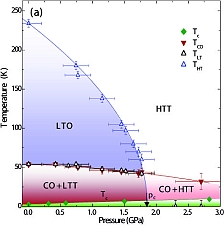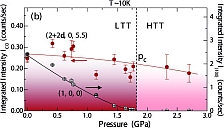Figure 1: Pressure cell used at BW5: (A) Pressure cell body from hardened high strength Co-Ni-Cr-Mo alloy (MP35N), (B) 360° X-ray window with a transmissibility of 14% of the incident photon flux at E = 100 keV, (C) Teflon sample cup. The total length of (A) is 51 mm, the maximum yet achieved pressure is p=2.7 GPa. Details of the pressure cell are described in Ref. [8].
M. Hücker1, M. v. Zimmermann2, M. Debessai3, J. S. Schilling3, J. M. Tranquada1, and G. D. Gu1
1. Condensed Matter Physics & Materials Science Department, Brookhaven National Laboratory, Upton, New York 11973-5000, USA
2. Deutsches Elektronen Synchrotron DESY, Notkestraße 85, D-22607 Hamburg, Germany
3. Department of Physics, Washington University, St. Louis, Missouri 63130, USA
Published as: “Spontaneous Symmetry Breaking by Charge Stripes in the High Pressure Phase of Superconducting La1.875Ba0.125CuO4”, Phys. Rev. Lett. 104, 057004 (2010).
Competing magnetic and electronic interactions in the cuprate high temperature superconductors often result in nanoscale inhomogeneity of the charge and spin density, a property that could be relevant to the unconventional superconductivity. A very interesting example is the spin and charge stripe order in the copper-oxide planes of La1.875Ba0.125CuO4. Theoretically, stripe order would break the rotational and translational symmetry of the planes, but so far it was observed only in distorted phases, where the reduced crystal symmetry allows for alternative explanations. If stripe order represented a fundamental instability, one would expect to see it develop in otherwise undistorted planes. We have used pressure to tune the lattice of La1.875Ba0.125CuO4 to have fourfold symmetry, and apply X-ray diffraction to demonstrate that, indeed, charge stripes spontaneously break the symmetry.
The prototypical high-temperature superconductor La2-xBaxCuO4 (LBCO) is particularly well known for its anomalous doping dependence of the superconducting transition temperature Tc(x) [1,2]. While in most other cuprate superconductors Tc(x) describes a simple dome, LBCO shows an additional deep depression centred at x = 1/8. Extensive research on the 1/8-anomaly revealed that here the superconductivity is replaced by a magnetic phase with a stripe like modulation of the charge and spin density, resulting in incommensurate magnetic as well as nuclear superstructure reflections [3,4,5]. Therefore it is of tremendous interest to understand whether these stripe correlations are relevant to the still unknown mechanism of superconductivity, or whether they constitute a less significant state that simply competes with bulk unconventional superconductivity.
To address this question we have performed X-ray diffraction experiments which demonstrate that stripes indeed represent a fundamental electronic instability. Motivated by theoretical proposals [6], it was essential to show that the charge stripe order spontaneously breaks the fourfold rotational symmetry of the copper-oxide planes. At ambient pressure, however, the lattice symmetry of those cuprate superconductors that show evidence of stripe correlations, is already reduced from fourfold to twofold, thus obscuring any intrinsic electronic instability. In the case of LBCO hydrostatic pressure can be used to tune the crystal symmetry, and to restore fourfold symmetry at a critical pressure pc [7]. If the crystallographic anisotropy drives the charge stripe order, we would expect this order to disappear at pc. In sharp contrast, our X-ray diffraction study demonstrates that charge stripe order survives in the fourfold symmetric high pressure phase. This surprising result strongly suggests that stripe correlations in the cuprates are electronically driven and intrinsically break the fourfold symmetry of the planes.
The detection of charge stripe order with X-ray diffraction is challenging, since even its strongest superstructure reflections are seven orders of magnitude weaker than the strongest Bragg peaks, thus making single crystal diffraction mandatory. The high pressure environment reduces the signal to noise ratio by another order of magnitude. All experiments were performed with the triple-axis diffractometer at wiggler beamline BW5 at DORIS III, which provides ~1011 photons/sec/mm2 at E = 100 keV, and is equipped with an analyzer crystal and a point detector to reduce the background. The pressure cell (Fig. 1) was specifically designed for BW5, and is optimized for bulk property studies of cubic millimetre size crystals in transmission geometry [8]. Because of the small scattering angles for 100 keV photons, the the pressure cell’s 360° X-ray window can be oriented parallel as well as perpendicular to the scattering plane, thus providing full access to the reciprocal space.
The temperature versus pressure phase diagram in Fig. 2a summarizes our findings for La1.875Ba0.125CuO4. All structural phases with twofold average rotational symmetry, i.e., the orthorhombic high temperature phase (LTO) and the tetragonal low temperature phase (LTT), are suppressed, and the high temperature tetragonal phase with a fourfold symmetry of the copper-oxide planes is restored at a critical pressure of pc = 1.85 GPa. In contrast, the charge stripe order continues to exist beyond pc.
In fact both the charge order transition temperature in Fig. 2a and the charge order peak intensity in Fig. 2b only show a modest decrease with pressure. On the other hand the superconducting transition temperature Tc barely increases, indicating that charge stripe order remains the dominating ground state in the high temperature tetragonal (HTT) phase where it spontaneously breaks the fourfold symmetry of the copper oxide planes. These results support theoretical proposals for dynamic electronic correlations that should intrinsically break the fourfold symmetry, and may constitute an electronic analog of a smectic or nematic liquid crystal state [6].
| References | ||||||||||||||||
|
| Contact information |
|
Markus Hücker |
| Further Information |








